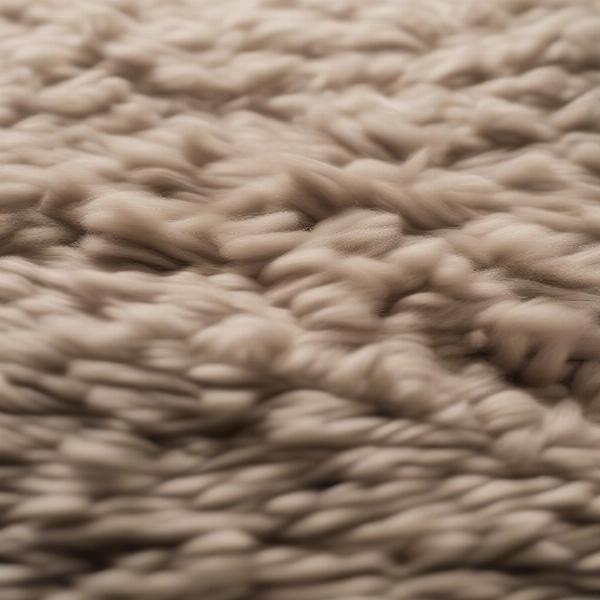Shedding is a natural process for dogs, but excessive shedding can be a nuisance. While no dog food can completely eliminate shedding, the right diet plays a crucial role in maintaining a healthy coat and minimizing fur loss. Choosing the best dog food to help with shedding involves looking for specific ingredients that support skin and coat health. This article will explore those key ingredients and help you understand how nutrition can impact your dog’s shedding.
Understanding the Link Between Diet and Shedding
A dog’s coat reflects their overall health. A dull, dry coat and excessive shedding can often indicate nutritional deficiencies. Just like humans, dogs need a balanced diet with the right vitamins, minerals, and fatty acids to support healthy skin and hair growth. Feeding your dog a high-quality diet rich in these essential nutrients can significantly improve coat condition and reduce shedding.
 Dog Shedding Fur on Carpet
Dog Shedding Fur on Carpet
Key Ingredients in Dog Food for Shedding
Certain ingredients are particularly beneficial for reducing shedding. Look for dog foods containing:
- Omega-3 Fatty Acids: These essential fatty acids, found in fish oil and flaxseed oil, nourish the skin and coat, promoting a healthy shine and reducing inflammation that can contribute to shedding.
- Omega-6 Fatty Acids: While not as potent as Omega-3s for shedding, Omega-6 fatty acids are still important for overall skin health and contribute to a healthy coat. Look for a balanced ratio of Omega-3 to Omega-6.
- High-Quality Protein: Protein provides the building blocks for hair growth. Choose dog foods with easily digestible protein sources like chicken, fish, or lamb.
- Vitamins and Minerals: Vitamins like A, C, and E, and minerals like zinc and biotin, are essential for skin health and coat growth.
Choosing the Right Dog Food
Selecting the best dog food to help with shedding can be overwhelming. Consider the following factors:
- Life Stage: Puppies, adults, and seniors have different nutritional needs. Choose a food formulated for your dog’s specific life stage.
- Breed Size: Small, medium, and large breeds have varying metabolic rates and require different amounts of calories and nutrients.
- Allergies and Sensitivities: If your dog has allergies, choose a hypoallergenic or limited ingredient diet to minimize potential triggers.
What to Avoid in Dog Food for Shedding
Certain ingredients can exacerbate shedding. Avoid dog foods with:
- Artificial Colors and Flavors: These additives can irritate the skin and contribute to allergies, which can worsen shedding.
- Fillers: Fillers like corn, wheat, and soy offer little nutritional value and can contribute to digestive issues, indirectly impacting coat health.
- By-products: By-products are low-quality ingredients that can be difficult to digest and may not provide the necessary nutrients for a healthy coat.
Beyond Diet: Other Factors Affecting Shedding
While diet plays a crucial role, other factors can influence shedding:
- Breed: Some breeds naturally shed more than others.
- Season: Dogs often shed more during seasonal changes.
- Health Conditions: Underlying health issues can contribute to excessive shedding. Consult your veterinarian if you notice sudden or significant changes in your dog’s shedding.
Conclusion
Choosing the right dog food to help with shedding is a key step in maintaining your dog’s overall health and minimizing fur around your home. By focusing on a diet rich in Omega-3 fatty acids, high-quality protein, and essential vitamins and minerals, you can support a healthy coat and reduce excessive shedding. Remember to consult your veterinarian for personalized recommendations based on your dog’s specific needs and breed.
FAQ
- What is the best dog food for shedding? There’s no single “best” dog food, but look for one with Omega-3s, high-quality protein, and no fillers.
- Can dog food completely stop shedding? No, shedding is a natural process, but the right food can minimize it.
- How long does it take to see results? It can take several weeks to notice a difference in shedding after changing dog food.
- What else can I do to reduce shedding? Regular brushing and grooming can help manage shedding.
- Should I be concerned about sudden excessive shedding? Yes, consult your veterinarian as it could indicate a health issue.
- Are there any supplements that can help with shedding? Talk to your vet about adding Omega-3 supplements to your dog’s diet.
- Can allergies cause increased shedding? Yes, allergies can cause skin irritation and inflammation, leading to increased shedding.
Related Articles
ILM Dog is a leading international website dedicated to providing expert advice and resources for dog owners worldwide. We offer comprehensive information on dog breeds, health, training, nutrition, grooming, and much more. With a focus on providing practical and reliable guidance, we strive to empower dog owners to provide the best possible care for their furry companions. Whether you’re a seasoned dog owner or just starting your journey, ILM Dog has the resources you need. Contact us at [email protected] or +44 20-3965-8624 for personalized guidance.